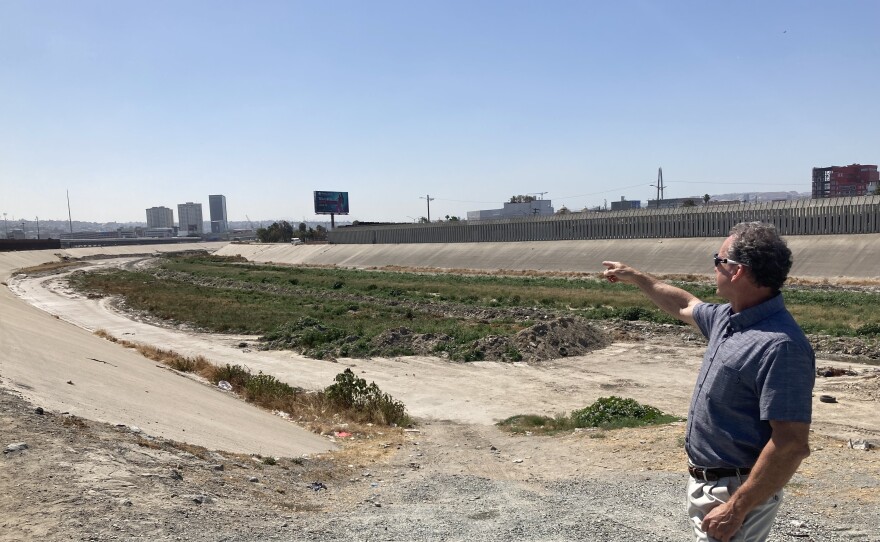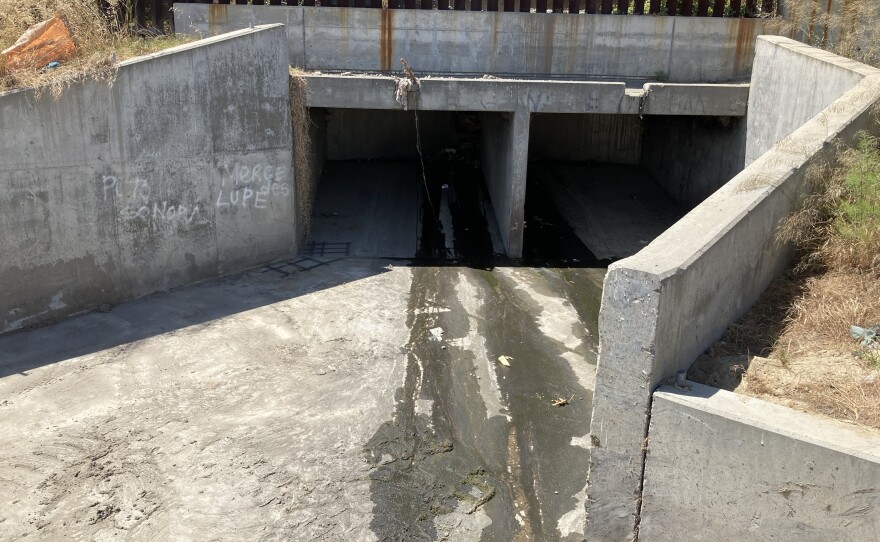The big fix for the region’s border sewage problem remains several years away, but that does not mean sewage will flow unabated until then.
Some recent smaller-scale projects are already having an impact on the dry-weather flows coming through the Tijuana River channel. And planning for a large-scale fix continues moving forward.
“This is the lined portion of the channel,” Morgan Rogers said as he surveyed the Tijuana River at the border.
“That’s where it transitions to the natural,” Rogers said. “This is a good view point: You can see all the sediment that has accumulated. This is from the wet season.”

Rogers is a civil engineer in charge of pollution control on the U.S. side of the border. He works for the International Boundary and Water Commission (IBWC), a federal agency responsible for managing, with Mexico, pollution issues along the border.
The concrete channel spills into the Tijuana River estuary and is a conduit for pollution that fouls the ocean just a few miles away.
“You can see, when it rains, when we get rainwater, it carries a lot of sediment, a lot of trash,” Rogers said.
But, when it’s not raining, most sewage-tainted flows can be stopped by a relatively low-tech solution.
“What we have here is a sediment berm,” Rogers said. “This is composed of the sediment that was deposited on the concrete-lined channel. This is constructed and maintained by Mexico. We provide the equipment, in particular a wheeled loader and whatever else they need in constructing the berm and maintaining it.”
There is standing water behind the sediment wall.

A few hundred yards north, a Mexican pump station pulls most of the water out of the river channel.
“During the dry season,” Rogers said, “this is very effective for preventing flows from coming down the river and crossing the border into the United States."
And there are other small success stories. Rogers drove to a nearby culvert just north of the border wall.
“This is Stewart’s drain, one of our five canyon collectors,” Rogers said.
This concrete channel runs under that busy road and under the border fence. Iron bars keep people from using it to cross the border.
Just a few feet away, an underground gate was locked in place, making heavy sewage flows difficult to manage.
With the valve now fully open, heavy flows of polluted water are easier to manage.
On this day, there was a trickle of water coming through the drain, but it was hardly an issue for Rogers. The flow crossed the border and was immediately collected in a drain that flows to the International Wastewater Treatment Plant.
“So this isn’t something I wouldn’t worry about,” Rogers said. “I mean we want to eliminate all flows, but we’re handling this one.”

The progress by the IBWC has been noticed and is welcome.
“I’m very happy with what I call the microfixes that the IBWC has made,” Imperial Beach Mayor Serge Dedina said. “Microfixes that can stop flows that can result (in avoiding) weeks of closures.”
Stopping the flow of sewage through the Tijuana estuary helps, but those microfixes don’t solve the border pollution problem. His city's beaches have been labeled as polluted for much of the summer because of a broken sewage treatment plan in Mexico.
“They discharge 30 to 50 million gallons of raw sewage on the beach every day — I think it's 4 1/2 to 6 miles south of the border,” Dedina said. “And, during south swell and south wind, that comes up to Imperial Beach, as well as all the other discharge sites south from Playas to Rosarito.”
That is one reason why the U.S. Environmental Protection Agency is pushing for a comprehensive solution that includes projects on both sides of the border.
Federal officials are currently vetting a $630 million plan to build more sewage treatment capacity on the U.S. side of the border, construct diversion systems that capture and hold flows until there is a chance to clean the water, add pumping stations and infrastructure in Tijuana, and build a new treatment plant near the ocean south of Tijuana.

The EPA has half of the money for the comprehensive cleanup plan, and local officials are actively pursuing additional funding.
Even so, it will still be a couple of years before constructions starts on any major sewage treatment plants.
“It’s not fast enough, but it is a priority for us,” said Nora Vargas, vice chair of the San Diego County Board of Supervisors.
Vargas worries about the reaction to unexpected beach closures in the South Bay this summer.
A new faster and higher-quality ocean water test being used by the county uncovered pollution off the coast of Imperial Beach and Coronado in May and June, a time when those beaches are full of tourists and usually pollution-free.
That pollution likely came from the broken sewage plant south of Tijuana.
Vargas does not want that situation to become a distraction for communities that have long endured the pressure of a public health emergency.
“Let’s not villainize the test,” Vargas said. “Let’s not make it about businesses or community. Let’s make it about our communities being safe and healthy so everyone can enjoy the beauty of our beaches in Southern California and South Bay.”









